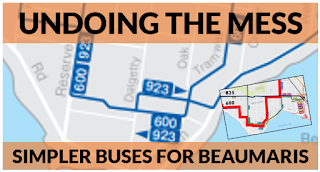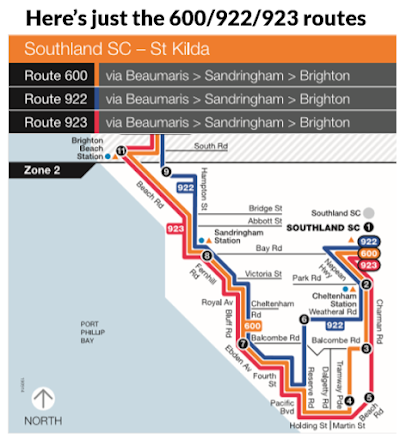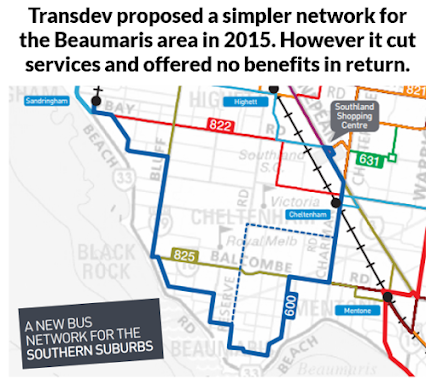Sometimes you can pinpoint a single date when an area's bus network goes from being good to bad. For Black Rock and Beaumaris that date was August 5, 2002.
On that date the simple and frequent Route 600 (previously known as the 901) was split into three complex and infrequent routes: the 600, 922 and 923. This was a result of a network reshuffle that also affected routes 822 and 823. It was uncharacteristic for the time as Melbourne buses were just awakening from a long stupor and getting modest service improvements. For example the first pilot SmartBuses and new outer suburban Sunday services started on that date.
History
Beaumaris has some interesting transport history, as you can see below, with the Victorian Railways once running trams and later a replacement buses (which continues today in extended form).
So it got replaced by bus route 901, also run by VR. Bus history here. These replacement buses were coordinated with trains at Sandringham. They were popular with more than one bus sometimes needed to meet each train. Route 901 was later extended to Southland Shopping Centre when that opened. It got taken over by the Metropolitan Transport Authority (The Met) when the Victorian Railways was broken up in the 1980s.
The 901 became part of the extended 600 from St Kilda in 1993. 1993's 600 timetable shows a basic half-hourly service on weekdays. However trips appear to have been added in the 1990s, with a 15 minute service operating by later that decade. That 15 minute service neatly matches the train at Sandringham (also every 15 minutes). Further reorganisation saw 600 became part of the privatised Melbourne Bus Link in the '90s and Transdev more recently.
The 600 retained its long operating hours (a tram/ex government legacy) but had its frequency halved when the 822 and 823 were shortened and parts replaced by new routes 922 and 923. The 922 and 923 are about 80% the same as the 600 with some deviations where the old versions of the 822 and 823 went.
Existing Useful Network
I define the Useful Network as the network of routes that operate every 20 minutes or better, peak and interpeak on weekdays. They also need to have 7 day service. Qualifying services in the Beaumaris area include the 825 between Moorabbin and Mentone and the overlapping portion of the 600 / 922 / 923 from Sandringham until just before the Concourse shopping centre. These routes do not qualify east of there because they fan out to operate a less frequent service.
A revised Useful Network
Black Rock and Beaumaris are not high population growth areas. Their demographics are skewed towards older richer people who use buses less than younger poorer people. Hence buses are quieter than average for Melbourne. However there is still a need for adequate network coverage. Opportunities exist for improved buses to relieve parking pressure at stations at Sandringham and across to the Frankston line. Also Mentone has a large number of schools likely to attract students living in the Black Rock/Beaumaris area.
What this means is that local bus revisions are justified but need to be very cost-effective. Places like Springvale, Tarneit and Craigieburn are crying out for new buses. As soon as you put a new bus on, even if it's only every 40 minutes, people crowd it. Whereas buses in the likes of Brighton can run frequently into the small hours yet get little use.
Black Rock and Beaumaris are more like Brighton than Braybrook. Analysis and efficient planning is key. In particular you would study the usage of existing routes. If it's low you could divert some resources into simplifying the network or improving frequencies of stronger routes.
There are four routes in play. These are the long-established 825 between Moorabbin and Southland and the mostly identical and often overlapping 600, 922 and 923. Of the latter three the 600 is dominant, with the longest operating hours. However the 825 has the highest frequency on weekdays with a 20 minute service provided.
Below are 2018 boarding statistics for the four routes concerned. They are average to slightly below average compared to other bus routes in Melbourne. And higher density or higher need areas might record 30 to 40 boardings per hour on their bus routes.
There are a few interesting things about these numbers. First of all Route 825 is highly dependent on school students. You can see that with the large fall off in usage on school holidays. 12 boardings per hour is low for a route that operates every 20 minutes all day. Of note is that Infrastructure Victoria regard 20 boardings per hour as being where a bus route ceases to be viable.
Development patterns have not been kind to the 825. These include (a) the decline of the Moorabbin town centre including its abolition as a municipality, (b) the construction of a Woolworths supermarket at Highett and (c) the construction of a station at Southland. These will have benefited other routes relative to the 825. Yet the 825 retains the same weekday frequency it had in 1991.
600/922/923's numbers should be regarded with caution. This is because (a) these are long routes with quieter and busier sections, (b) their erratic timetables including short workings and (c) the significant coverage overlaps with trains and other buses in the portion north of Sandringham. While old data, the Booz & Co bus review found that the 600/922/923 were busier between Sandringham and Southland (where there is unique coverage) than on the St Kilda - Sandringham section (where coverage is largely duplicative).
The above leads to four tentative conclusions.
* At least at non-school times Route 825 is over-serviced for the patronage it gets. Its relevance has declined due to the opening of Southland Station and continued overlaps with other routes (eg 708, 600/922/923). The Mentone - Southland portion might be redundant, although it's only a few minutes of bus run time.
* There is a continuing need for bus access to schools, including in the Mentone area.
* Route 600/922/923 should be simplified back into a single route operating more frequently along the 600 alignment. 20 minutes is possibly the ideal frequency given patronage levels and would make a revised network cheaper to run than what is there now. However it does not evenly meet trains every 15 minutes at Sandringham. While on the generous side a 15 minute frequency would meet trains. And it matches what currently runs with the 600/922/923 corridor so can be done without increasing costs.
* Coverage at all stops be retained given the hostile reaction to the proposed 2015 network.
The map below shows what a revised network might look like. It's greatly simplified. The centrepiece is the restored high frequency Route 600 running every 15 minutes on weekdays and 20 minutes on weekends. This would run from Sandringham to Southland like the old 901 did. Other arrangements discussed in Useful Network Part 8, would apply north of Sandringham.
Implementation and costs
Conclusion
What do you think of this network? Would it be an improvement? If you have any comments or ideas please leave them below.
PS: An index to all Useful Networks is here.











4 comments:
Further north, the old route 600 (which was also an ex-VR tramway, from Brighton to St Kilda) also fed into the railway, with a very frequent service up until the 1980s, including extra peak services from Elwood to St Kilda. This was despite being run by a private operator at the time, unlike the 901 it eventually merged with.
In other parts of Melbourne, most of the ex-MMTB routes have not changed much, but at least haven't been completely messed up like the 600-922-923 was.
I like your analysis and agree the buses in Beaumaris need to be reformed, particularly the confusing 600/922/923 series. I am close by to this area so I have some understanding of local travel needs.
I don't agree with reducing frequency of the 825 as this provides a direct route to Black Rock and Beaumaris from Mentone and I believe has reasonable school patronage. I think the 825 would have a stronger northern terminus by continuing North on Bluff/Cummins Road than a short section north west on Nepean Highway up Thomas Street and Centre Road to terminate at Bentleigh Train Station. Given Bentleigh is a busier and more popular activity centre than Moorabbin this may generate more usage and would be the first north-south full route along Bluff Road/ Cummins Road.
I think a new 600 high frequency smart bus style service would be beneficial in the Beaumaris area as you have mentioned.
I think a missing link (I believe you have mentioned earlier) is a fast frequent service from Sandringham Station to Southland (one of the major trip generators in the area). This can be done by modifying the route of the 822 to run all the way along Bay Road to stop at Southland (skipping Cheltenham Station and Activity Centre) and than could continue on to to Chadstone. What needs to happen ultimately, is the bus interchange at Southland needs to be relocated to be adjacent to Southland Train Station (where the new SRL station will go). This will facilitate far superior multi modal interchanges. This may help reduce commuter parking pressures, particarily at Sandringham, which does not have adequate car parking for being a station at the end of the line which services multiple suburbs: Black Rock, Beaumaris, Sandringham and even some Highett/Cheltenham commuters may use this station.
Peter said:
Peter, I'm confused. Your proposed bus route network map for the Brighton-Hampton region shows 600, 922 and 923 as they are now. Also, your changes do nothing for the worst-served areas, namely East Brighton straddling Dendy Street and along Nepean Highway, which has the hourly 823 running between dawn to late afternoon but nothing on weekends. Why not run 600 (with 922 and 923 consolidated into 600) between Sandringham station and north Brighton, either along all of Hampton Street and Bay Street, or from Sandringham via Beach Road, Hampton Street, Dendy Street, Well Street, thence New Street (past all the schools and Cabrini Hospital - big trip generators), Bay Street, St Kilda Street along its current route to Barkly Street St Kilda, but then re-route it along Carlisle Street to a terminus near Luna Park?
Unknown - for Dendy St I'd likely extend the 701 to Brighton. Definitely agree with a Nepean Hwy route from Elsternwick to Southland and possibly to Mentone. Latter is discussed in Useful Network No 18. I'd definitely consolidate 600/922/923. UN Part 8 is one possibility for the Brighton area. UN8 also has a simplified Hampton St route.
Post a Comment